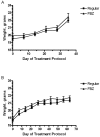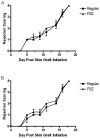Effects of fenbendazole on routine immune response parameters of BALB/c mice
- PMID: 19049250
- PMCID: PMC2687137
Effects of fenbendazole on routine immune response parameters of BALB/c mice
Abstract
Fenbendazole (FBZ) is an anthelmintic drug widely used to treat and prevent pinworm outbreaks in laboratory rodents. Although data in nonrodent species indicate possible effects of fenbendazole on the bone marrow and lymphocyte proliferation and function, little has been reported regarding possible effects on the rodent immune system. The purpose of the current study was to determine the effects of a therapeutic regimen of FBZ on immune parameters in BALB/c mice. Both 9-wk on-off and 5-wk continuous medicated feed protocols were assessed. No significant differences between normal and FBZ diet treated mice were observed in the following parameters: complete blood count, blood chemistry, quantitation of major T and B cell markers in spleen, quantitation of T cell markers in the thymus, spleen cell proliferation to T and B cell mitogens, bone marrow colony-forming cell assays, skin graft rejection, and primary and secondary humoral immune responses. These data indicate that FBZ treatment does not affect many standard broad measures of immune function.
Figures


Similar articles
-
Effect of fenbendazole on an autoimmune mouse model.J Am Assoc Lab Anim Sci. 2013;52(3):286-9. J Am Assoc Lab Anim Sci. 2013. PMID: 23849411 Free PMC article.
-
Effects of fenbendazole on the murine humoral immune system.J Am Assoc Lab Anim Sci. 2009 May;48(3):251-7. J Am Assoc Lab Anim Sci. 2009. PMID: 19476712 Free PMC article.
-
Biologic effects of fenbendazole in rats and mice: a review.J Am Assoc Lab Anim Sci. 2007 Nov;46(6):8-15. J Am Assoc Lab Anim Sci. 2007. PMID: 17994667 Review.
-
Prophylactic fenbendazole therapy does not affect the incidence and onset of type 1 diabetes in non-obese diabetic mice.Int Immunol. 2006 Mar;18(3):453-8. doi: 10.1093/intimm/dxh385. Epub 2006 Jan 13. Int Immunol. 2006. PMID: 16415097
-
Cellular immune responses in peripheral blood lymphocytes of Giardia infected squirrel monkey (Saimiri boliviensis boliviensis) treated with Fenbendazole.PLoS One. 2018 Nov 9;13(11):e0198497. doi: 10.1371/journal.pone.0198497. eCollection 2018. PLoS One. 2018. PMID: 30412580 Free PMC article.
Cited by
-
Effect of fenbendazole on an autoimmune mouse model.J Am Assoc Lab Anim Sci. 2013;52(3):286-9. J Am Assoc Lab Anim Sci. 2013. PMID: 23849411 Free PMC article.
-
Effects of fenbendazole on the murine humoral immune system.J Am Assoc Lab Anim Sci. 2009 May;48(3):251-7. J Am Assoc Lab Anim Sci. 2009. PMID: 19476712 Free PMC article.
-
An Update on the Biologic Effects of Fenbendazole.Comp Med. 2022 Aug 1;72(4):215-219. doi: 10.30802/AALAS-CM-22-000006. Epub 2022 Jun 28. Comp Med. 2022. PMID: 35764389 Free PMC article.
-
Effects of fenbendazole on fecal microbiome in BPH/5 mice, a model of hypertension and obesity, a brief report.PLoS One. 2023 Jun 9;18(6):e0287145. doi: 10.1371/journal.pone.0287145. eCollection 2023. PLoS One. 2023. PMID: 37294797 Free PMC article.
-
Effect of fenbendazole on three behavioral tests in male C57BL/6N mice.J Am Assoc Lab Anim Sci. 2010 Nov;49(6):821-5. J Am Assoc Lab Anim Sci. 2010. PMID: 21205447 Free PMC article.
References
-
- Agersborg SS, Garza KM, Tung KS. 2001. Intestinal parasitism terminates self tolerance and enhances neonatal induction of autoimmune disease and memory. Eur J Immunol 31:851–859 - PubMed
-
- Barron S, Baseheart BJ, Segar TM, Deveraux T, Willford JA. 2000. The behavioral teratogenic potential of fenbendazole: a medication for pinworm infestation. Neurotoxicol Teratol 22:871–877 - PubMed
-
- Bugarski D, Jovcic G, Katic-Radivojevic S, Petakov M, Krstic A, Stojanovic N, Milenkovic P. 2006. Hematopoietic changes and altered reactivity to IL17 in Syphacia obvelata-infected mice. Parasitol Int 55:91–97 - PubMed
-
- Cabaj W, Stankiewicz M, Jonas WE, Moore LG. 1994. Fenbendazole and its effect on the immune system of the sheep. N Z Vet J 42:216–220 - PubMed
MeSH terms
Substances
LinkOut - more resources
Full Text Sources
